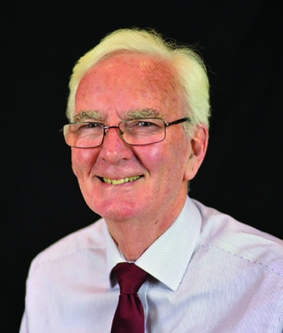I am stepping down as Editor-in-Chief of The Aeronautical Journal at the end of May. This was not an easy decision to make, as I have very much enjoyed being involved with the Journal over a period of some 15 years but it was time for a younger person with fresh ideas and fresh energy to take over the reins. My association with the Journal began in the early 2000s when the Editor at the time, Professor John Stollery, invited me to take over the Chair of a small editorial group that had been set up by Eric Rogers of the National Physical Laboratory to oversee the production and development of the Journal. The Group, which continues to meet monthly, consisted at the time of the Editor, the Chairman and key members of the Publications Department. In May 2005, the Group was strengthened by the arrival of Professor Mike Graham. Unfortunately personal reasons forced John Stollery to retire from the Editorship in December 2006 and he asked if I would take over the position. I agreed and Mike Graham then became the Chairman of the Editorial Group. More recently, the Group, which is now entitled the Editorial Committee of The Aeronautical Journal, was strengthened further by the appointment of Professor Chris Atkin as Deputy Chairman.
During John Stollery's time as Editor it became clear that scientific publishing was changing rapidly and if a journal first published in January 1897 was to survive, changes were essential. Up to then all papers were handled internally, including the selection of referees, while many of our competitors had recruited Associate Editors with specialist knowledge in their areas of expertise. John established the Journal's Board of Associate Editors and its membership continues to expand as the range of topics that come under the heading of aerospace increases and Associate Editors are being recruited from a growing number of countries. Another change we considered during this period was the possibility of moving the production, distribution and marketing of the Journal to one of the rapidly growing specialist publishers of scientific journals with the aim of attracting more readers and increasing the number of papers submitted. However, at the time this was considered a too revolutionary change.
When I took over as Editor we continued to seek ways to improve the Journal. One early change was to reduce the size of the printed version to 245 mm × 170 mm, at the same time increasing the number of pages, to make it easier to carry around and read while travelling. However, such a change was limited in its effect as most readers were moving from the hardcopy to the online version. During my time as Editor the impact factor of a journal became a key performance indicator that supposedly measures the quality of a publication. The impact factor is based on a calculation related to the number of citations papers receive. However, no matter how good a paper might be, if it is not readily available to the global aeronautical community it is less likely to be cited. With its relatively limited resources the Society could not match the online presence offered to our competitors by well-known publishing houses. This time a proposal to team up with a specialist publisher was greeted with enthusiasm. In January 2016 Cambridge University Press (CUP) published its first issue of The Aeronautical Journal. As a result, the Journal's web presence has been transformed, one highlight being that it includes access to all 122 volumes published since 1897.
I am extremely pleased that Professor Holger Babinsky has accepted the invitation to become the next Editor-in-Chief of the Journal. Holger is Professor of Aerodynamics in the Engineering Department at Cambridge University and very well qualified to take on the Editorship. Interestingly, Holger's first supervisor in the UK was none other than Professor John Stollery.
My parting would not be complete without thanking members of the Publications Department headed by Chris Male. Special thanks go to Wayne Davis and Annabel Hallam for their continued dedication to making the Journal a success. While CUP is now responsible for printing, distributing and marketing the Journal, Wayne and Annabel remain responsible for handling all papers submitted, communicating with Associate Editors and ensuring papers are subjected to a rigorous peer review process. Wayne is the Production Editor and carries the additional important role of liaising with CUP. In large part it is thanks to their efforts that during my Editorship the number of papers submitted per year has doubled, the number of papers published per issue has increased and the impact factor has shown a significant rise. I would also like to thank Simon Whalley, Head of External Affairs and also a member of the Editorial Committee, for his helpful advice on matters relating to the Society. Finally it would be a very serious omission if I was not to acknowledge the support received from Simon Luxmoore, Chief Executive of the Society. He strongly encouraged the move to an external publisher, appreciating the importance of such a development to the future success of the Journal. I also thank him for hosting a meeting of Associate Editors in December each year and for including a most appetising lunch.
I wish The Aeronautical Journal every success in the future and I am confident it is in secure hands.

Professor Peter Bearman, Editor-in-Chief, January 2007 – May 2018

